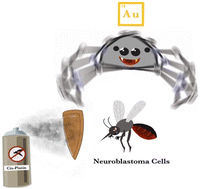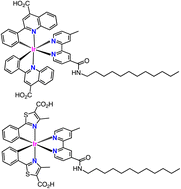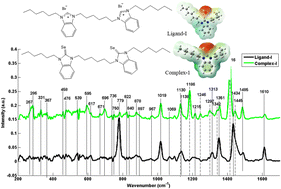
RSC Advances
Subject area
Coordination chemistry articles published in the last
6 months

The crucial role of hydrogen bonding in shaping the structures of zinc-based coordination polymers using tridentate N, N, O donor reduced Schiff base ligands and bridging acetates
In this article synthesis, characterization and DFT study of two polynuclear zinc(II) complexes with reduced Schiff base have been reported.

RSC Adv., 2024,14, 13905-13914
https://doi.org/10.1039/D4RA00550C
Formation of H-bonding networks in the solid state structure of a trinuclear cobalt(III/II/III) complex with N2O2 donor Schiff base ligand and glutaric acid as bridging co-ligand: synthesis, structure and DFT study
Formation of hydrogen bonding network in a trinuclear linear mixed-valence centrosymmetric cobalt(III)–cobalt(II)–cobalt(III) complex has been analyzed using DFT calculations.

RSC Adv., 2024,14, 13200-13208
https://doi.org/10.1039/D3RA07697K
Application of a distinctly bent, trinuclear, end-to-end azide bridged, mixed valence cobalt(III/II/III) complex in the fabrication of photosensitive Schottky barrier diodes
A trinuclear cobalt(III)-cobalt(II)-cobalt(III) complex has been synthesized and used to fabricate a Schottky barrier diode. The conductivity of the synthesized complex-based device improves considerably in illumination conditions from the non-illuminated conditions.

RSC Adv., 2024,14, 11185-11196
https://doi.org/10.1039/D4RA01406E
Synthesis, characterization, and biomedical evaluation of ethylene-bridged tetra-NHC Pd(II), Pt(II) and Au(III) complexes, with apoptosis-inducing properties in cisplatin-resistant neuroblastoma cells
New ethylene-bridged N-heterocyclic carbene ligand systems and their respective transition metal complexes are characterized and the electronic properties are discussed.

RSC Adv., 2024,14, 10244-10254
https://doi.org/10.1039/D4RA01195C
Synthesis, structural, spectroscopic and electric/dielectric studies of a nanocrystalline Ni(II) complex based on [(1,3-diphenyl-1H-pyrazol-4-yl)methylene]thiocarbonohydrazide
A Ni2+ nanocomplex based on a heterocyclic ligand containing a pyrazole moiety was developed in this work, and its electric conductivity and dielectric characteristics were studied.
![Graphical abstract: Synthesis, structural, spectroscopic and electric/dielectric studies of a nanocrystalline Ni(ii) complex based on [(1,3-diphenyl-1H-pyrazol-4-yl)methylene]thiocarbonohydrazide](/en/Image/Get?imageInfo.ImageType=GA&imageInfo.ImageIdentifier.ManuscriptID=D4RA00665H&imageInfo.ImageIdentifier.Year=2024)
RSC Adv., 2024,14, 9747-9757
https://doi.org/10.1039/D4RA00665H
Accurate assembly of thiophene-bridged titanium-oxo clusters with photocatalytic amine oxidation activity
We synthesized a crystalline dumbbell-shaped Ti10, which effectively enhances charge transfer. As a result, it exhibits remarkably high conversion activity and selectivity in the photocatalytic oxidative coupling reaction of benzylamine.

RSC Adv., 2024,14, 7924-7931
https://doi.org/10.1039/D4RA00117F
Alkyl chain functionalised Ir(III) complexes: synthesis, properties and behaviour as emissive dopants in microemulsions
Luminescent, alkyl chain functionalised Ir(III) complexes have been synthesised, characterised and studied in microemulsion environments showing retention of emissive behaviour.

RSC Adv., 2024,14, 6987-6997
https://doi.org/10.1039/D3RA06764E
Closed-shell d10–d10 mechanochromic [AuPh(CNPh)]n complex: quantum chemistry electronic and optical properties
[AuPh(CNPh)]2 complexes are modeled, and their electronic properties, optical properties, and solid state chemistry are studied.
![Graphical abstract: Closed-shell d10–d10 mechanochromic [AuPh(CNPh)]n complex: quantum chemistry electronic and optical properties](/en/Image/Get?imageInfo.ImageType=GA&imageInfo.ImageIdentifier.ManuscriptID=D3RA08935E&imageInfo.ImageIdentifier.Year=2024)
RSC Adv., 2024,14, 5638-5647
https://doi.org/10.1039/D3RA08935E
Highly selective separation of tetravalent plutonium from complex system with novel phenylpyridine diamide ligands
Three phenylpyridine diamide ligands displayed high selectivity for Pu(IV) over other metals in a HNO3 medium. They also demonstrated good stripping ability and reusability, with reasonable radiolytic stability up to an absorbed dose of 100 kGy.

RSC Adv., 2024,14, 560-567
https://doi.org/10.1039/D3RA07418H
New triazole-based coordination complexes as antitumor agents against triple negative breast cancer MDA-MB-468 cell line
The synthesis of a new family of seven new coordination complexes, with remarkable cytotoxicity and high selectivity index towards cancer cells when compared to peripheral blood mononuclear cells (PBMCs) is reported.

RSC Adv., 2023,13, 36158-36167
https://doi.org/10.1039/D3RA07714D
Characterization of three different benzimidazolium ligands and their organo-selenium complexes by using density functional theory and Raman spectroscopy
In this study, Raman spectroscopy along with density functional theory (DFT) calculations have been performed for characterization of three different selenium-based N-heterocyclic carbene (NHC) complexes synthesized from their respective salts.

RSC Adv., 2023,13, 35292-35304
https://doi.org/10.1039/D3RA04931K
Reactivity of azido terpyridine Pd(II) and Pt(II) complexes towards 4,4,4-trifluoro-2-butynoic acid: structural insight into the triazolato coordination mode
The binuclear azido terpyridine Pd(II) complex underwent the catalyst-free cycloaddition coupling with alkyne affording triazolate analogues. The coordination mode of the triazolate ring was assigned with the aid of quantum chemical calculations.

RSC Adv., 2023,13, 34826-34835
https://doi.org/10.1039/D3RA06656H
Carpe diene! Europium-catalyzed [3,3] and [5,5] rearrangements of aryl-pentadienyl ethers
A catalytic and highly regioselective method for the rearrangement of aryl-pentadienyl ethers into the corresponding ortho- or para-alkylated products.
![Graphical abstract: Carpe diene! Europium-catalyzed [3,3] and [5,5] rearrangements of aryl-pentadienyl ethers](/en/Image/Get?imageInfo.ImageType=GA&imageInfo.ImageIdentifier.ManuscriptID=D3RA05641D&imageInfo.ImageIdentifier.Year=2023)
RSC Adv., 2023,13, 32077-32082
https://doi.org/10.1039/D3RA05641D
Ligand effect of cyclometallated iridium(III) complexes on N-alkylation of amines in hydrogen borrowing reactions
Dinuclear iridium complexes with the general formula (C^N)2Ir(μ-Cl)2Ir(C^N)2 (C^N = bidentate ligand with carbon and nitrogen donor atoms) were prepared and used in catalytic systems for N-alkylation of amines through the hydrogen borrowing pathway.

RSC Adv., 2023,13, 31948-31961
https://doi.org/10.1039/D3RA07184G
Browse by Subject
- All (347 articles)
- Atomic/elemental (15 articles)
- Bioanalytical (72 articles)
- Chemometrics (31 articles)
- Crystallography (174 articles)
- Electroanalytical (60 articles)
- Imaging/microscopy (34 articles)
- Mass spectrometry (25 articles)
- Medical diagnostics (84 articles)
- Microfluidics (16 articles)
- Nanoanalysis (21 articles)
- Separation science (27 articles)
- Spectroscopy (97 articles)
- All (277 articles)
- Bioinorganic chemistry (53 articles)
- Bioorganic chemistry (29 articles)
- Biotechnology (46 articles)
- Cellular chemistry (62 articles)
- Computational (88 articles)
- Drug delivery (74 articles)
- Drug discovery (189 articles)
- Imaging/diagnostics (15 articles)
- Molecular biology (7 articles)
- Nanotechnology (40 articles)
- Natural products (30 articles)
- Pharmacology (96 articles)
- Photobiology (17 articles)
- Polymorphism (pharma) (1 article)
- Structural biology (12 articles)
- Toxicology (3 articles)
- All (562 articles)
- Biomaterials (103 articles)
- Biopolymers (99 articles)
- Carbon materials (103 articles)
- Composites (245 articles)
- Electronic materials (92 articles)
- Encapsulation (1 article)
- Energy applications (83 articles)
- Films/membranes (82 articles)
- Gels & soft matter (35 articles)
- Inorganic materials (50 articles)
- Medical materials (66 articles)
- Nanomaterials (126 articles)
- Optical materials (50 articles)
- Organic materials (51 articles)
- Polymers (126 articles)
- All (347 articles)
- Assembly (10 articles)
- Biotechnology (29 articles)
- Carbon nanomaterials (82 articles)
- Imaging/microscopy (15 articles)
- Nanoanalysis (39 articles)
- Nanocatalysis (34 articles)
- Nanomaterials (219 articles)
- Nanomedicine (40 articles)
- Nanotoxicology (51 articles)
- Optical nanomaterials (33 articles)
- Synthesis (13 articles)
- All (185 articles)
- Bioorganic (18 articles)
- Catalysis (46 articles)
- Fine chemicals (27 articles)
- Natural products (25 articles)
- Physical organic (9 articles)
- Stereochemistry (11 articles)
- Supramolecular (3 articles)
- Sustainable synthesis (36 articles)
- Synthetic methodology (108 articles)
- Total synthesis (14 articles)
- All (336 articles)
- Biophysics (2 articles)
- Charge transfer (30 articles)
- Electrochemistry (12 articles)
- Energy research (19 articles)
- Imaging/microscopy (6 articles)
- Kinetics & dynamics (43 articles)
- Materials (108 articles)
- Mechanics (34 articles)
- Nanoscience (73 articles)
- Photoscience (29 articles)
- Quantum & theoretical (95 articles)
- Simulations (23 articles)
- Single molecules (46 articles)
- Soft matter (5 articles)
- Spectroscopy (7 articles)
- Surfaces & interfaces (73 articles)